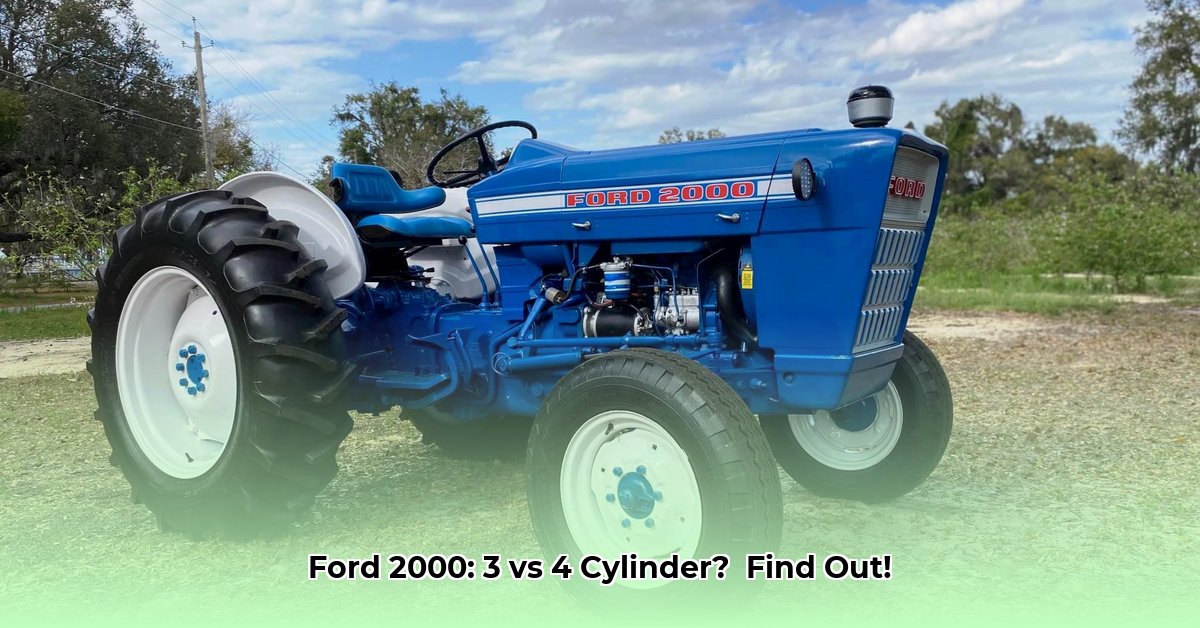
The Ford 2000 tractor, a stalwart of agricultural machinery, is known for its reliability and versatility. This guide directly compares the two main engine variations: the 3-cylinder and the 4-cylinder models. We'll delve into horsepower, PTO power, transmission options, hydraulic systems, and other crucial specifications to help you determine which Ford 2000 best suits your needs. The challenge lies in the inconsistencies reported in horsepower figures across various sources; we aim to clarify this ambiguity. For more detailed specs, see this Ford 2000 data.
Model Variations: 3-Cylinder vs. 4-Cylinder Power
The core distinction between the Ford 2000 variants lies in their engines. The 4-cylinder engine boasts significantly more power than its 3-cylinder counterpart. However, precisely quantifying this difference proves difficult due to variations in reported horsepower figures. These discrepancies stem from inconsistencies in testing methodologies and the varying conditions of the tractors tested. Consequently, the horsepower figures presented below are estimates based on available data.
| Engine Type | Claimed Horsepower (HP) (Estimate) | Estimated PTO Horsepower (HP) |
|---|---|---|
| 4-Cylinder | 40-45 HP | 30-35 HP |
| 3-Cylinder | 30-35 HP | 20-25 HP |
Note: These horsepower figures are estimates compiled from various sources. Actual horsepower may vary.
The Power Take-Off (PTO) horsepower – the power available to operate implements – shows a considerable difference, directly impacting the workload each model can handle. The 4-cylinder model easily tackles more demanding tasks, while the 3-cylinder model is better suited for lighter agricultural work. Do you need the extra muscle for heavy tillage or large-scale operations, or will a smaller, more fuel-efficient model suffice? This key question shapes your choice.
Transmission Options: Navigating the Gears
The Ford 2000 offered a wide range of transmission options, including 4-speed, 5-speed, 6-speed, 8-speed, 10-speed, and 12-speed gearboxes, sometimes with power-shift capabilities. This variety makes direct comparison challenging, as the specific transmission impacts performance significantly. Always check the specific transmission type of the tractor you are considering. The transmission, working in tandem with the engine's horsepower, significantly influences fuel efficiency and overall performance. A precise comparison needs to account for this highly variable component.
Hydraulic Systems: Lifting Capacity
Both engine types utilized an open-center hydraulic system. However, the 4-cylinder models generally offered higher hydraulic pressure and flow rates, resulting in a greater lifting capacity and improved efficiency when operating larger implements. The 3-cylinder model remains capable but falls short in lifting heavier loads. Before purchasing, carefully consider the hydraulic demands of your intended agricultural operations.
Other Key Features: A Comparative Overview
Beyond engine and transmission specifications, other factors differentiate the two Ford 2000 models. These include weight, dimensions, and fuel tank capacity. The 4-cylinder model typically weighs more and features larger dimensions compared to the 3-cylinder model. This often translates to a greater fuel tank capacity as well.
| Feature | 4-Cylinder | 3-Cylinder |
|---|---|---|
| Weight | Heavier | Lighter |
| Dimensions | Larger | Smaller |
| Fuel Capacity | Larger fuel tank capacity | Smaller fuel tank capacity |
| Overall Build | Typically constructed for heavier tasks | Generally suited for lighter work |
These differences highlight the variation in capabilities between the two tractor versions. The 4-cylinder model proves ideal for demanding applications, while the 3-cylinder model fits lighter workloads.
Conclusion: Selecting the Right Ford 2000
Choosing between a 3-cylinder and 4-cylinder Ford 2000 requires careful consideration of your farming needs, budget, and the availability of parts. This comparison has highlighted the key differences in horsepower, PTO power, transmission options, hydraulic capabilities, and overall build. Remember to also consider factors such as fuel efficiency and the cost of maintenance when making your decision. Thorough research is crucial; the correct Ford 2000 will greatly enhance your farm's productivity.